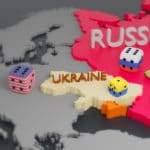Elections 2024 in US and Russia may decide the battlefield developments in Ukraine

“The absence of a victory will call into question the legitimacy of Russia’s 2024 elections,” Andrei Fedorov, former deputy foreign minister of Russia, said.
Tanks, mercenary convicts and imminent offensives look set to decide battlefield developments as the war in Ukraine nears its first anniversary. But when 2023 comes to an end, the conflict’s fate may be decided elsewhere: by votes not just in the United States but in Russia, too.
While domestic issues will dominate next year’s U.S. presidential election, how Americans vote could have a profound impact on the country’s policies on Ukraine and Russia. It’s not only the American presidential election that is on the horizon: Russian President Vladimir Putin is also set to go to the polls in 2024.
After stamping out and, in the case of leading opposition leader Alexei Navalny, imprisoning viable opposition movements and figures, victory for Putin is pretty much guaranteed in 2024. But in order to achieve an indisputable victory in the polls, his military will have to achieve unquestioned success on the battlefields of Ukraine.
On Wednesday, a senior Ukrainian official warned that hundreds of thousands of Russian troops were massing on the border ahead of an expected offensive. These numbers could reach 500,000, Defense Minister Oleksii Reznikov said.
“We do not underestimate our enemy,” he said on French television. “Officially they announced 300,000, but when we see the troops at the borders, according to our assessments it is much more.”
But if Russian forces are defeated, or continue to suffer humiliating defeats, Putin’s position will be more precarious back home, Andrei Fedorov, former deputy foreign minister of Russia, told last week.
“Things might be [a] little different if Russia will not be successful. The absence of a victory will call into question the legitimacy of Russia’s 2024 elections,” he said.
Shifting demographics will also prove a challenge, Federov added. With older Russians who make up the majority of Putin’s power base naturally dying off, younger urbanites who have historically populated the ranks of the now-beleaguered opposition may become more influential.
“Remember that in the elections of 2024 there will already be … fewer voters of the Soviet generation, and quite critical youth may vote,” he said.
With Ukraine preparing for renewed fighting in the coming months, the recent diplomatic tussle between Germany and the United States over supplying Ukraine with Western heavy tanks pulled back the curtain on tensions over the outcome of upcoming battles.
“Americans like winners, and if Ukrainians are on the offense in 6-8 months, then I think you’ll see a lot more support,” a senior aide to a Republican senator said.
“Part of the challenge here is to set the conditions now so they can get success so you can maintain American support,” said the aide, who spoke on condition of anonymity because they are not authorized to speak on the record.
The supply of tanks, which crucially come with a lot of already produced ammunition, will be important, he said.
But Ukraine also needs “long-range artillery, mines and cluster munitions to drive an enemy into ‘kill boxes’ that you then strike fast with tanks, armored personnel carriers and mounted infantry,” the aide said. “As they move they need to be supported by layered air defense and offensive close air support.”
He predicts another slow process:
“The Germans and U.S. are going to resist helicopters and fighters. You can’t tell Ukraine to fight like a Western military and not give them this stuff, but it will still be painfully slow for them to get it.”
While support for Ukraine is pretty close to universal in Congress, Republicans are split on how far to go and how much aid to provide, with some on the right of the party suggesting that Americans should focus on challenges closer to home instead of spending billions on a foreign war.
A group of nine countries including the United Kingdom and Poland are now the tip of the diplomatic spear arguing for more offensive support.
“Ukraine needs to strengthen her defensive firepower and to be able to move from resisting to expelling Russian forces from Ukrainian soil,” British Ambassador to the United States Karen Pierce told. In what became known as the Tallinn Pledge, this alliance of nine countries wrote last month that “equipping Ukraine to push Russia out of its territory is as important as equipping them to defend what they already have.”
The countries also called for supplies of not just main battle tanks, heavy artillery, ammunition and infantry fighting vehicles but also air defense.
Some countries behind the pledge say that if Ukraine can threaten Crimea, which Russia annexed in 2014 after a referendum that was not recognized by most of the international community, it will force Putin into genuine talks to end the war.
That’s not guaranteed, however.
“President Putin is ready to give the toughest answer and prevent Ukraine from even reaching the isthmus leading to Crimea,” Federov said. “Here he will stop at nothing. This is more than a principle for him.”
Putin has indicated that he, too, sees the current arms race as a deciding factor. Last month he scolded his trade and industry minister for not producing weapons fast enough.
“Too long, too long, I ask you to expedite this work,” Putin told Denis Manturov on state television.
“Everything will be decided in February-March,” Federov said. “When each side will try to change the situation at the front in its favor. But the result may be a transition to a long war.”
A long war will need to be sold to voters in Russia, the U.S. and if it is long enough, the United Kingdom, where the election does not have to be held until January 2025. That may seem way off, but wars have a history of lasting longer than expected.
Source: www.nbcnews.com










